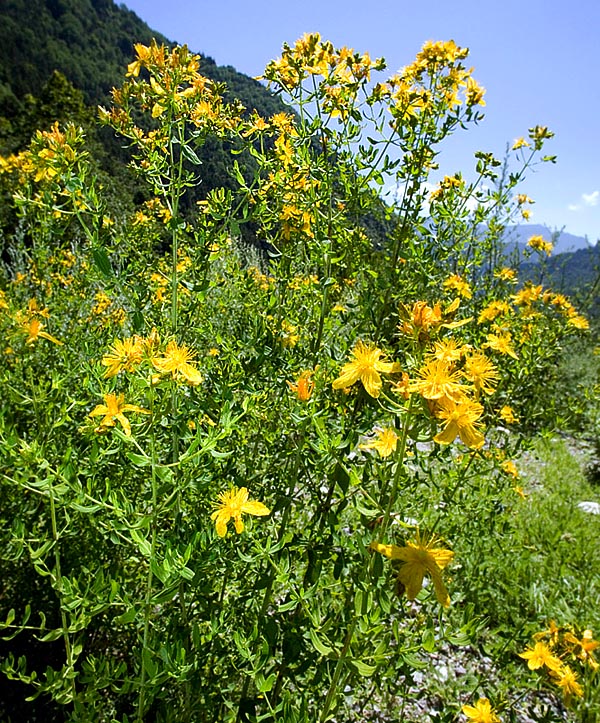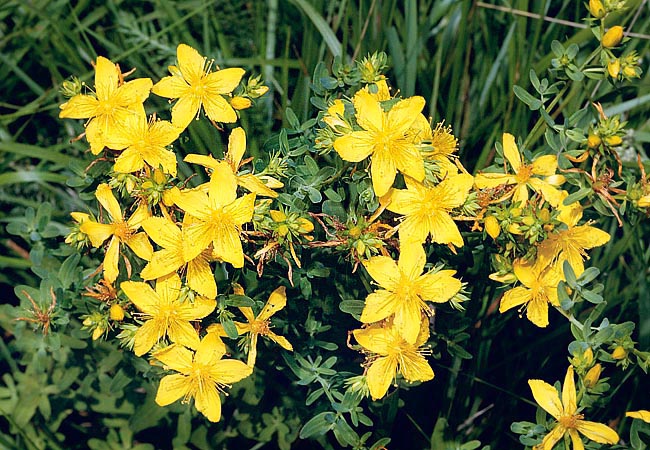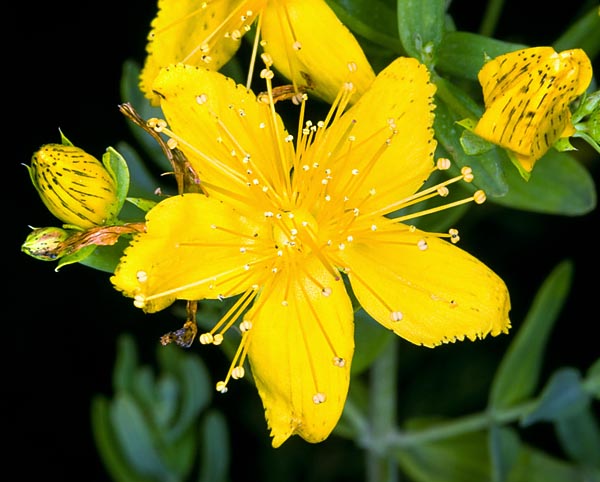Family : Hypericaceae

Text © Eugenio Zanotti

English translation by Mario Beltramini

Hypericum perforatum is now present in the whole world temperate climate zones © Giuseppe Mazza
The interpretation of the genus name is controversial: some want it connected to the heathlands from the Greek “ypo” = under, and “erike” = heath, others, from “upper” = beyond, and “heicon” = image, due to the transparent dotting of the leaves (perforated). For others, from the Greek “yper” = over and “eicos” = resemblance because of the presence on the petals of an element recalling an image; “-ico” comes from the verb “eico” = “I am similar to..”.
The name of the species comes from the Latin “perforo” = to perforate, with reference to the numerous translucent gland making the foliar lamina to look as pitted.
Known also as common St. John’s wort, rosin rose, goatweed, Klamath weed, chase-devil (the tradition dictates that it is to be harvested on June 24th, St. John’s Day, midsummer day, for making small bundles to be hung on the front door as protection against the devils), the Hypericum perforatum is a perennial, glabrous, 20-70 (100) cm tall, herb.
The stems are rather rigid, crossed longitudinally by two pronounced lines, prostrate and lignified at the base.
The leaves are opposite, sessile or nearly so, ovate-lanceolate, dotted with translucent glands and with glands dark on the border.
The flowering, in the northern hemisphere, is concentrated between May and August. The flowers have 5 golden yellow petals twice as long than the sepals, and are arranged in multi-flowered corymbs. A blood-red sap flows if they are pulled off their peduncles.
The fruits are trilocular capsules. It lives in the dry grasslands, the sparse and dry scrubs, the borders of the woods and of the roads, the wastelands, the old walls and the formations with synanthropic vegetation (0-1600 m). It is one of the symbols of the summer solstice. For the phytotherapeutic uses they collect, during the summer, the flowering tops called “Herba Hyperici”.

The flowers, arranged in corymbs, have 5 gold yellow petals twice as long as the sepals © Giuseppe Mazza
These active principles confer St. John’s wort topical-vulnerary (external use), capillarotropic and astringent properties.
For internal use, the drug has an anti-depressant action and relieves nervous disorders, treats the inflammations of the bronchi, of the urinary system and, generally, of all the abdominal organs.
It is antiseptic, decongestant and balsamic, useful for asthma, the hepatic insufficiencies, the enuresis, and for the difficult digestions. Extracts of Hypericum perforatum are utilized in the Russian clinics for the inflammatory forms of the bronchi and of the genitourinary tracts, due to the balsamic, antibacterial, anti-catarrhal and antiphlogistic activity. For external use it is employed as efficacious vulnerary, anti-inflammatory, and cicatrizant, as it holds an antiviral and antibacterial activity.
A useful infusion for the inflammations and the bronchial and vesical catarrhs is prepared with a spoonful of flowered tops chopped and crushed in a pot of boiling water. Leave to infuse a quarter of an hour, filter, press well the residue, and then sweeten to taste with honey. To be prepared and drunk lukewarm twice-thrice a day far away from the meals.

It's a symbol of midsummer, with remarkable medicinal virtues © Giuseppe Mazza
Synonyms: Hypericum perforatum var. albiflorum Choisy (1824); Hypericum marylandicum Biroli ex Colla (1833); Hypericum pseudoperforatum Bertol. (1844); Hypericum lineolatum Jord. (1855); Hypericum deidesheimense Sch. Bip. ex Trevir. (1871); Hypericum mixtum Des Moul. (1867); Hypericum perforatum var. alpinum Parl. (1872); Hypericum perforatum var. anomalum Frit. (1887); Hypericum perforatum var. microphyllum H. Lév. (1907).
→ To appreciate the biodiversity within the HYPERICACEAE family please click here.
